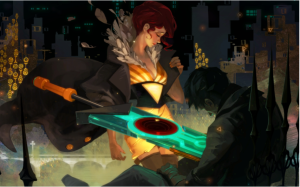If you’ve played a single-player videogame in the last ten years, more than likely the experience involved a character yammering in your ear as you navigated the story, telling you what to do and where to go. This might be one character for the whole game, such as Cortana in Halo, a number of different people, like the Control team in XCOM: Enemy Unknown, or one for each mission, like the million vagrants and scoundrels who put you to work in any given iteration of Grand Theft Auto. The point is, despite being the greatest badass who ever lived and the saviour of all mankind, you probably spent much of the experience feeling like you were schlepping around at the behest of someone who couldn’t even be bothered leaving that one spot directly outside the inn. RPGs are especially prone to this trope, with the mechanics of Borderlands and its sequel only making any sort of sense if literally every person besides the player character is an actual paraplegic cruelly deprived of wheelchair technology. Not every game works like this, of course – some are content to have instructions for the player pop up on screen, while others like Alan Wake or Murdered: Soul Suspect feature leads who talk to themselves, and by proxy the player. Nevertheless, it’s common enough that I feel confident in calling the instructional narrator is one of the most common tropes in video games today.

The relationship these characters have to the player is complex. They need to serve two purposes – to give necessary, story-advancing information to the character, and to tell the player what they need to do next in a strictly mechanical sense. Sometimes the outcome of this double duty becomes absurd – Solid Snake’s commander literally telling him to press the action button to jump while rappelling in Metal Gear Solid leaps to mind – and some games subvert the relationship entirely, such as the amazing twist at the end of the original Bioshock. For most games, though, it’s the narrator characters who are in charge of the proceedings, even when they’re technically subordinate to the player character within the fiction of the game. Commander Shepard might be the Captain of the Normandy, but when Joker or Liara tell her to be somewhere, she has to be there, otherwise the game simply can’t progress to the next part. I’m going to try not to tumble too far down the rabbit hole of ludonarrative dissonance, but suffice to say that these three people – narrator, character and player – sit in a delicate balance necessary to provide both a story and a game, even when those two aspects are sometimes at direct odds with one another.

This trope is particularly important in talking about Transistor. The second outing from Supergiant Games, this action RPG follows on the heels of critical darling Bastion and, in this nerd’s opinion, more than lives up to its predecessor’s reputation. I’m going to leave it up to other, more professional reviews to praise the stellar music, lush graphics, intriguing story and intricate, rewarding combat mechanics in order to focus on one topic – voice. You see, our protagonist Red is a singer who has been stripped of her voice by the villains, an initially vague force known only as The Process, leaving her wielding a sword (the titular Transistor) that contains the essence of a mysterious man whose relationship to her is unclear to the player for the majority of the story.
It’s this mystery man whose voice we hear as we play the game, and at first the concept made me roll my eyes. A female lead who is literally voiceless, acting at the beck and call of a male character? I picked up this game looking for a dynamic action heroine, not some errand girl. Then, something happened. At the end of the first section, the Transistor tells Red the route to take to get to the docks, leave town and escape The Process. I assumed that this would be what happened next in the game – after all, the disembodied voice is instructing the player in what to do to advance the game’s plot, right? Wrong. In the following cutscene, Red gets on her motorcycle and heads back into the centre of town, bringing the fight directly to the bad guys. It’s a tiny moment, but one that upends the entire character-player-narrator trifecta in a single stroke. The narrator might be the only one whose voice that we can hear, but this scene makes it very clear that the agency is entirely in Red’s hands.

Unlike any of the disembodied voices listed before, the Transistor is very much not in charge. Red acts and he reacts, rather than the other way around. This can be motivating, such as when he congratulates her on landing a powerful combo on an enemy, or heartbreaking – I won’t spoil it, but there’s a moment when Red visits her apartment on the way to confront The Process that stuck with me for the rest of the game. Either way, it’s effective, all the more so given that we never even get to hear Red speak. In a way, she doesn’t need to – like countless cowboys, vigilantes and Men Of Few Words before her, she lets her actions to the talking.
This fact becomes all the more interesting when we look at it in terms of gender. Red is a woman, and for all the progress we’ve made in the last hundred years we still expect to see women in the subordinate role in action stories, especially those in video games. With a few notable examples, women in video games exist to motivate the hero with their death, to be captured and rescued, or to give aid and sustenance to the masculine hero. They don’t drive the story, but merely exist to support it.
Transistor is very different to this, and not just because the main character is a woman, but also because of the role of the man. As the story unfolds the Transistor continues to offer Red advice, though this is usually functional information pitched more at the player than at her – pointing out when they’re backtracking through an already cleared area, or are about to miss a vital recharge point. His commentary on the story and on Red’s mission is consoling, concerned and generally encouraging – a supportive role, which in a more traditional story would almost definitely have fallen to a woman. I can’t help but feel, even to hope, that this was intentional on the part of the good people at Supergiant, that they were deliberately seeking to undermine traditional narrative roles when they chose the genders of Transistor’s two protagonists.

To be clear, I’m not saying that video games shouldn’t feature a character who instructs the player in how to proceed. Without Liara shouting to reroute the comms console (or shut off the AA guns or deliver the virus or whatever), Mass Effect players would be left guessing as to what was expected of them to proceed. The more open the game’s world, the more complex this proposition is, to the point where games like Oblivion feature appointment books in which the character keeps track of the many demands of their various masters. Transistor’s gameplay is quite simple, and its story linear – the combat is deep, but outside of that the player really just needs to run through a series of rooms and staircases. This simplicity of form leaves the developers free to experiment with the basic building blocks of videogame narrative, to outstanding result. Of course, it’s not like plenty of other games with linear environments haven’t felt the need to put a monkey on the player’s back, directing the player (and by proxy, the character) in every step they take – I’m looking at you, Remember Me.
The depiction of women in video games has come a long way, but there are still battles yet to be fought. This is an industry, after all, in which a female critic can’t catalogue games featuring Damsels in Distress without suffering an avalanche or rape threats, a major publisher states that it’s simply “too difficult” to include a female character in one of the biggest and best funded games of the year, and including women in the design and testing process is somehow a noteworthy, Herculean effort. A medium overburdened with stories of manly men doing many things, in which women are far too often relegated to the sidelines. There are female gamers out there, increasingly frustrated by their lack of representation in the characters and the stories presented by their chosen medium, and they are increasingly vocal about what they want – just check out the Twitter hastag #womenarehardtoanimate, the locus of the various responses to Ubisoft’s latest PR bungle. Transistor is a massive step in the right direction, a game that doesn’t just feature a female lead but that also acknowledges the context that this exists in and plays with convention in all sorts of interesting ways.
That reason – along with a million others – is good enough for me to say that this is already one of my favourites of the year, and more than good enough for you to jump on Steam or Playstation Online and give it a go.
Alex Hardison is a thirtysomething gamer, comic book and SF reader, film nerd and geek for all seasons. He has had short fiction published in the webzine FLURB not once but twice, puts up his own at Volatile Memory, and blogs about comics at Notes From Crime Alley. He lives in Sydney with his girlfriend and cat, and if you don’t like Babylon 5 he will fight you.




